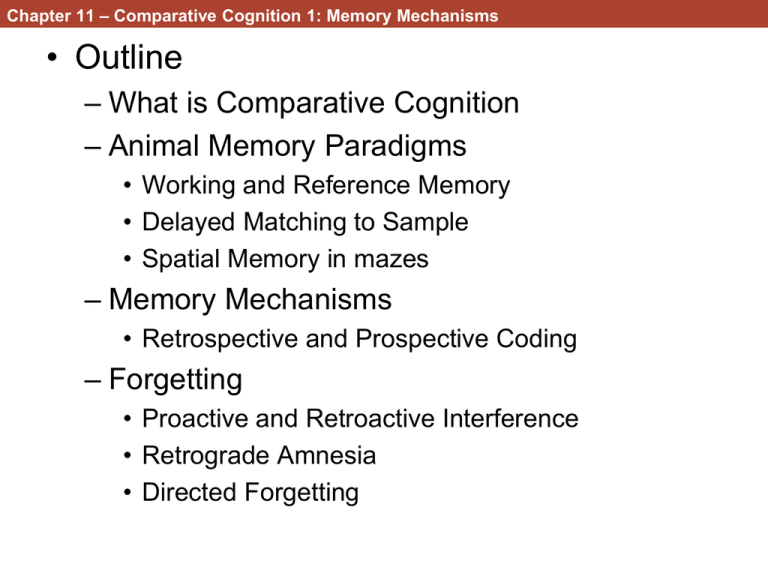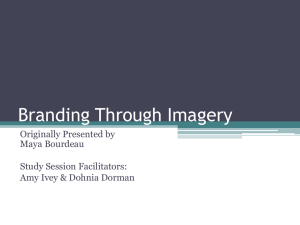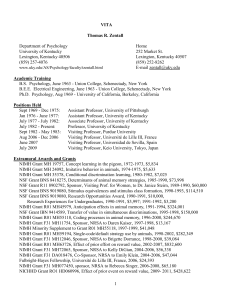Comparative Cognition 1: Memory Mechanisms
advertisement

Chapter 11 – Comparative Cognition 1: Memory Mechanisms • Outline – What is Comparative Cognition – Animal Memory Paradigms • Working and Reference Memory • Delayed Matching to Sample • Spatial Memory in mazes – Memory Mechanisms • Retrospective and Prospective Coding – Forgetting • Proactive and Retroactive Interference • Retrograde Amnesia • Directed Forgetting • Chapter 11 - Animal Cognition 1: Memory Mechanisms • What is Comparative Cognition? – Zentall (1993) – Animal Cognition is often best understood by explaining what it is not. • Learned behavior that is left after simpler associative-learning explanations have been ruled out • We have already discussed an example of a cognitive experiment • Identity learning (Sameness) – Train (MTS) • RR+G• GR-G+ – Test • B B+Y• Y B-Y+ • Notice the test involves novel stimuli – This is often an important test in cognitive studies • It makes it difficult to explain performance in test based on S-R –O relationships. • There is no RF history of picking Blue following Blue • Seems more likely performance is the result of an understanding of “sameness” – A cognitive rule » Pick the thing that looks the same. What is Comparative Cognition? Continued • Domjan – Theoretical constructs and models used to explain aspects of behavior that cannot be readily characterized in terms of simple S-R or reflex mechanisms. • Key feature – Always adopt the simplest possible explanation What is Comparative Cognition? Continued • Must carefully avoid anthropomorphism • Morgan’s Canon – In no case may we interpret an action as the outcome of a higher psychical faculty, if it can be interpreted as the outcome of the exercise of one that stands lower in the psychological scale. – At first the allure is weak; there is a vague yearning and a mild agitation. Ultimately, the strength of desire grows irresistible; its head turns sharply and it skitters across the uneven floor to caress the objects of its affection with consummate rapture • Coin drawn to a magnet • There are more parsimonious explanations for this behavior – Clever Hans What is Comparative Cognition? Continued • Often involves models of mental activity – The internal clock (chapter 12) • A model for how a biological clock might work – Mental Representations • What is the nature of a memory? – It is not just a snap shot. – It is some how changed to a neural code – What is the nature of that code? • Animal Memory Paradigms • What is the difference between learning and memory? – The main difference is how we study each. • Study Learning – We vary aspects of acquisition – Hold retention interval and retrieval variables constant • Study Memory – Hold acquisition constant – Vary retention intervals or variables related to retrieval • Types of memory • Short term memory – the phone number for pizza place • Long term memory – Episodic • Picture yourself there (the episode) – What did you have for dinner last night? – What were you doing when you heard about the World Trade Center? » Flash bulb – Semantic • Facts about the world – Who was the first president? – What year were you born? – Procedural • How to do things – – – – ride a bike, drive, swim sports musical instruments write • Explicit (declarative) – Knowing that you know (conscious awareness) – Episodic is clearly declarative • the person is clearly aware of learning they experienced. • They have a conscious memory for it. – Semantic is as well • You know that-you-know the year you were born – Clive Wearing had no episodic memory at all » Still knew he had a wife and kids » No memory of spending time with them • Implicit (nondeclarative or procedural) – This is learning that you are not consciously aware of. • illustrated by priming experiments • Also H.M. – Mirror drawing task • Also Clive Wearing – Piano – Much of the Pavlovian and Instrumental research we have discussed would fall under procedural • We will discuss animal models of Episodic memory in Chapter 12 • Working Memory and Reference Memory – another distinction that has received a lot of research interest in comparative cognition • Reference Memory – Long-term retention of information necessary for the successful use of incoming and recently acquired information • The rules of the game • Working Memory – Short-term information • What did I just do? • Cooking – General recipe • rules for making the dish – Keep track of where you are • What have I already done • Walter Hunter (1913). – Rats, dogs, and raccoons. – Light indicates which of three compartments are baited. • animal is confined in start area. – Turn light on; then off to indicate which compartment was correct – They are not allowed to choose for various lengths of time. • Rats - 10 seconds. • Racoons – 25 seconds • Dogs – 5 minutes. – Reference Memory? – Working Memory? • Problem with the study • Matching-to sample – Simultaneous – Delayed • Why is this technique better than Hunter’s? – Eliminates behavioral explanation for retention • Face where you intend to go. • Animal has no way of knowing which key will be correct – Left vs. right = 50% • What affects an animals memory in a DMTS experiment? • 1) nature of the sample stimulus affects DMTS performance – Lines and shapes – Colors • 2. Sample Duration? – Grant (1976) • DMTS – 4 colors R,G,B,Y – Each trial begins with white center key » Warning stimulus – Peck turns to sample (i.e., Red) » Stays on for different durations » 1,4,8, or 14 s • Test with Delays (retention intervals) – 0, 20, 40, or 60 •Results (Figure 11.2) •trace-decay hypothesis (Roberts & Grant, 1976). •A simple idea, but clearly too simple. • 3) Similarity between training and testing conditions – Instruction hypothesis (Zentall) • What happens if animals are trained with a particular delay and tested with others? – Sargisson and White (2001). • Train with 0, 2, 4, or 6 s delays. • Test with 0, 2, 4, 6, 8, and 10 s delays. •Figure 11.3 •0 – normal forget curve •2 – forget curve does not start until 4 s •4 – forget curve does not start until 6 s •6 – no forget curve. •What does this say about forget curves? •Not just trace-decay •Similarity between training and testing conditions are important Spatial memory in mazes Spatial memory in mazes Spatial memory in mazes Morris Water Maze • Train in a room with external cues – Door – Pictures – Light gradients • Platform always in the same location – Release from 4 different locations • Randomly – North, South, East, West – Test? • Escape latency (figure 11.4) • Probe trials – Path analysis. • Probe trial mouse • Spatial memory in the Radial arm maze – Olton and Samuelson (1976) • Food at end of each arm – Or a subset of arms • Reference Memory? • Working Memory? • You-tube vids of 8 arm maze – Normal mouse – Knockout mouse with memory probs • How do the rats behave in radial arm maze? – Not a set sequence – No strategy – No odor cues – They can handle long delays • Let them choose four arms – four hours later they choose the other 4 • Even after 24 hours they are performing above chance • Retrospective and Prospective Coding • How do the rats keep track of the arms of the maze? – Retrospective • keep track of where they have been – Prospective • keep track of where they are going • Cook, Brown, and Riley (1985) • 12 arm maze – Let rats choose 1, 2, 3, 4, 5, 6, 7, 8 , 9, 10, 11 arms. – Remove the rat for 15 minutes – Put them back in and complete the maze. • retrospective memory – memory load would start out low – increases with arms visited – having a heavy memory load, should lead to more mistakes • predicts few errors after 1 choice • many errors after 11 choices. • prospective memory – Memory load starts out high • Have 11 arms still in memory – Decreases with arms visited – having a heavy memory load, should lead to more mistakes • Predicts many errors after 1 choice • Few errors after 11 choices • These predictions are in direct contradiction to one another. • What do rats do? • People? • Forgetting – Why does memory sometimes fail? • Proactive and Retroactive interference • Proactive interference – Previous memories disrupt current memory – Where did I park my car today? • Retroactive interference – New memories disrupt old memories • Cumulative exams? • Phone number from last apartment? – Address? • Amnesia – Anterograde • Unable to form memory for events that occurred after the injury – Retrograde • Loss of memory for events prior to injury • Squire’s electroconvulsive shock study – Indicates that memories are vulnerable for an exceptionally long time • 1 year old memories were especially vulnerable – Older memories were relatively unaffected • Implies some active processing of memory (memory consolidation) over an extended period of time. • Directed Forgetting – It is known that humans can exert cognitive control over memory. – Give a list of words to subjects to remember • Tell them “okay – that was just practice. Forget about that list and get ready for the real list” • After a retention interval you tell them that you lied. – Please write down as many words from the original list that you can • Compare to a group told to remember the list. – Memory for the list is much poorer for those told to forget. • Perhaps because they did not initiate memory maintaining strategies (rehearsal) • Can animals exert cognitive control over memory? • Omission Procedure – Phase 1 MTS • R R+G• GG+R- – Phase 2 DMTS with cues • • • • R-VR+GG-VG+RR-HITI G-HITI – Test • with forget cues – R-HR+G– G-HG+R- • Compare to remember cues – R-VR+G– G-VG+R- – Result? • Good performance on R-cued trials • Poor performance on F-cued trials • Problems with Omission Procedure? • Roper and Zentall (1993) – 1. no response requirement following F-cues • Pigeons are not used to making a choice following F-cues – Thus, disrupts responding in test – 2. no RF following F-cues. • F-cue could act as a conditioned inhibitor – Thus, disrupt responding in test – 3. Presentations of comparisons following Fcues is novel • The novel (or surprising) cues could disrupt performance • The substitution procedure corrects for the above issues. • Substitution Procedure – Phase 1 MTS • R R+G• GG+R- – Phase 2 DMTS with cues • • • • R-VR+GG-VG+RR-HB+YG-HB+Y- – Test • with forget cues – R-HR+G– G-HG+R- • Compare to remember cues – R-VR+G– G-VG+R- – Result? • Good performance on all trials • No evidence for directed forgetting • Compare the human situation to that of the pigeon – Maintaining a bunch of words in memory is demanding • Difficult to do – The pigeons do not have nearly the same demands • one sample to remember – Red or Green – There may be little cost to remembering regardless of the trial type. • What if we increase the memory demand? – Reallocation experiment • Roper, Kaiser, and Zentall (1995) • Train the pigeons with F-cues that they have to remember – If they have to reallocate memory to the F-cue perhaps it will disrupt memory for the original sample










